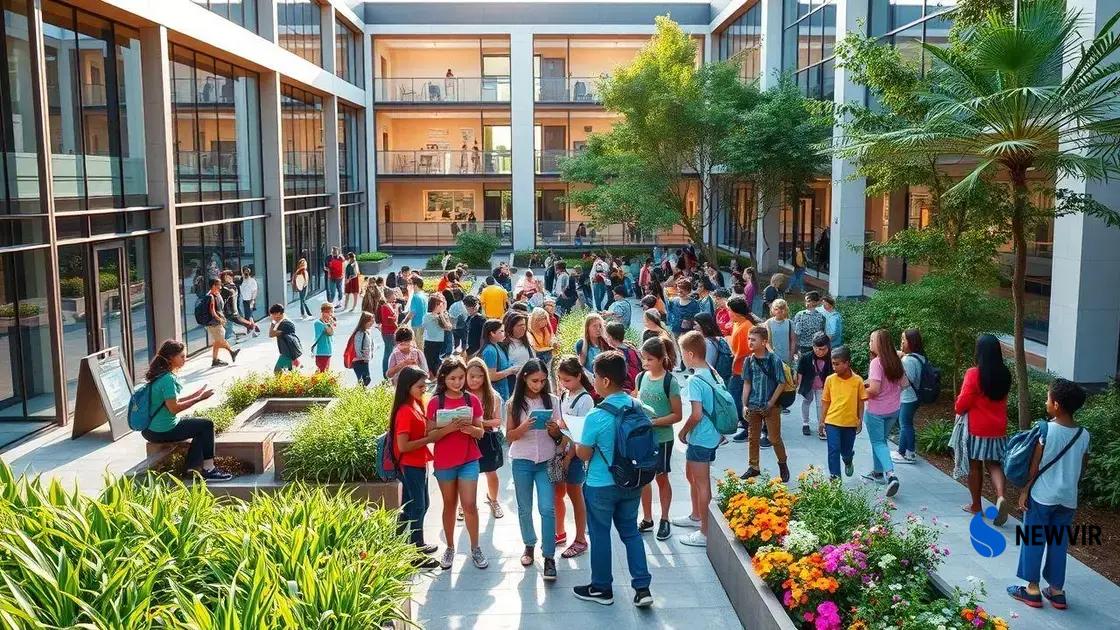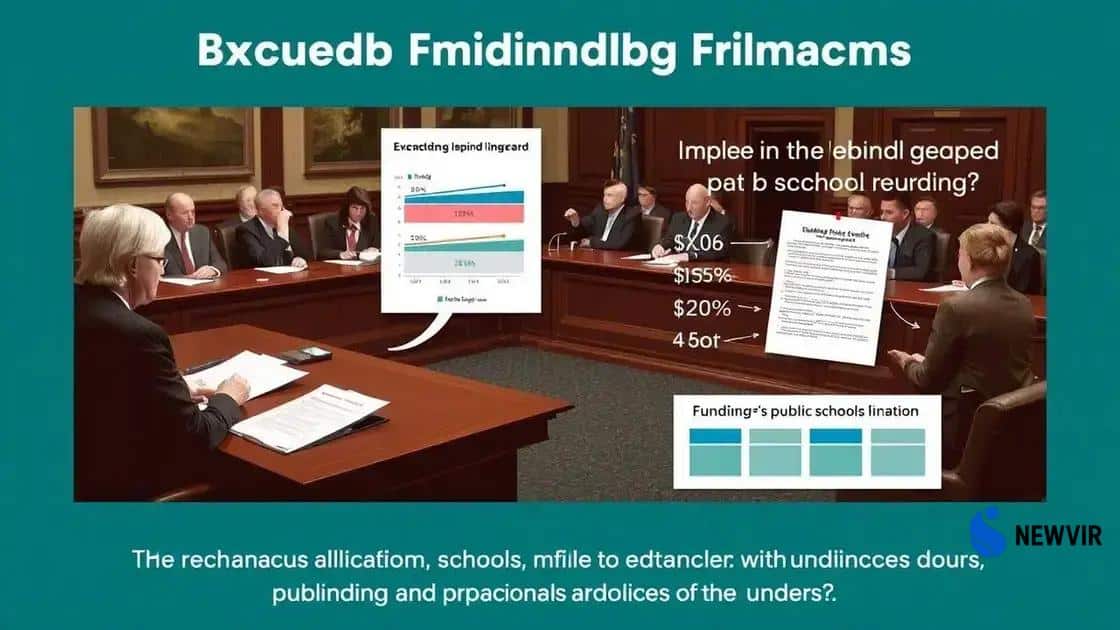Continued controversy over public school funding models

Continued controversy over public school funding models highlights disparities that affect educational quality, prompting calls for equitable reform through community engagement and legislative changes to ensure all students have access to necessary resources.
Continued controversy over public school funding models has sparked debates nationwide. How does this affect our schools, and what are the implications for our children’s education? Let’s explore.
Understanding public school funding models
Understanding how public school funding models operate is crucial for recognizing the challenges and benefits they bring to our education system. These models determine how schools receive money from various sources, and they can significantly impact the quality of education students receive.
Types of Funding Models
There are several key types of funding models used across the country, each with its own strengths and weaknesses.
- Local Funding: This model relies heavily on property taxes from the local community. While it can lead to well-funded schools in affluent areas, it often leaves underprivileged schools struggling.
- State Funding: Funded through state taxes, this model helps balance funding disparities. It aims to ensure that all schools receive a more equitable share of resources.
- Federal Funding: Provided by the federal government, this funding often targets specific programs, such as special education or low-income students.
By analyzing these models, we can see how they affect each school’s budget and resources. Funding models are often criticized for perpetuating inequality, especially in communities where property values are low.
Challenges in Funding
One significant challenge is the reliance on local funding. As mentioned, communities with high property values can afford better schools, while lower-income areas often struggle. This disparity leads to a wide gap in student performance across different regions.
Moreover, changes in legislation can abruptly alter funding structures. Local governments may face budget cuts that affect school funding. Schools might cut important programs like arts or sports if they do not receive adequate support.
As we delve deeper into the intricacies of public school funding, we understand the effects on students, teachers, and communities at large. The debate continues as to how best to reform these models for fairness and improvement.
The impact of funding disparities
The impact of funding disparities in public schools is significant and wide-ranging. These disparities can lead to stark differences in educational outcomes and opportunities for students based on their location and the wealth of their communities. As funding sources vary, so do resources, educational programs, and teacher quality.
Effects on Educational Quality
Schools in affluent areas often have access to better facilities, updated technology, and a wider range of extracurricular activities. This funding allows for smaller class sizes and more support staff, which enhances the learning experience. In contrast, schools in low-income areas struggle to provide basic supplies, let alone advanced programs.
- Teacher Qualifications: Higher funding often attracts more qualified and experienced teachers, while underfunded schools may face staffing challenges.
- Extracurricular Activities: Schools with ample funding can offer various sports and clubs, enriching the educational experience.
- Technological Resources: Access to modern technology is crucial. Schools lacking funds might not even have functioning computers.
These factors create a cycle of disadvantage. Students in poorly funded schools might not perform as well academically, limiting their future opportunities.
Social and Economic Consequences
Beyond classroom implications, funding disparities have broader social and economic effects. A lack of educational resources can lead to higher dropout rates in disadvantaged communities. This, in turn, affects job prospects and community growth. Families may find it challenging to break the cycle of poverty when their local schools do not provide them with the skills needed for success.
Moreover, communities with better-funded schools tend to have higher property values and more attractive neighborhoods. This can lead to further investment and resource allocation, creating a feedback loop that exacerbates existing inequalities.
Recent changes in funding legislation

Recent changes in funding legislation have significantly shaped the landscape of public school financing. These changes aim to address longstanding inequalities and improve educational outcomes for all students. Understanding these shifts helps us see the effort to balance resources across various communities.
Key Legislative Changes
Over the past few years, several key legislative changes have been implemented that affect how funds are allocated to schools. These laws often aim to close the funding gaps between wealthy and underprivileged areas.
- Equity-Based Funding Models: New policies have introduced equity-based funding models, ensuring resources are more evenly distributed based on student needs.
- Increased State Funding: Many states have increased their investment in public education, providing additional resources specifically targeted at low-income districts.
- Comprehensive Education Reform: Recent reforms also focus on comprehensive strategies to improve education, including investments in teacher training and mental health resources.
These legislative efforts mark a crucial step towards ensuring that all students, regardless of their background, have access to quality education.
Challenges and Responses
Despite the progress, challenges remain. Some districts still face opposition to changes, particularly those reliant on traditional funding models. The push for reforms often meets resistance from stakeholders who fear losing financial resources.
Additionally, the implementation of new laws can face hurdles. Schools require time and support to adapt to funding changes and ensure they meet the needs of their students effectively. Engaging communities in discussions around these changes is essential to foster understanding and support.
As amendments to funding legislation continue to unfold, keeping an eye on their impacts is crucial. The goal remains to create a more equitable educational system that serves every child well.
Voices from the community
Voices from the community play a vital role in shaping public school funding discussions. These perspectives help us understand the on-the-ground realities that students and educators face every day. Listening to community members can shine a light on how funding disparities affect education and quality of life.
Parents and Guardians
Parents often express their concerns over inadequate resources in underfunded schools. Their stories highlight how students are impacted by a lack of supplies, extracurricular programs, and experienced teachers. Many parents advocate for better funding, believing every child deserves a fair shot at a quality education.
- Calls for Action: Parents often organize community meetings or rallies to voice their demands for better funding.
- Real Experiences: Personal anecdotes can reveal the challenges students face in accessing a well-rounded education.
- Collaboration: Parents work with local organizations to raise awareness about funding issues.
Hearing these voices is key to driving systemic change.
Students’ Perspectives
Students themselves can offer unique insights into how funding impacts their education. Many students express frustration over crowded classrooms, outdated textbooks, and limited access to technology. Their firsthand experiences provide a powerful argument for reform.
By sharing their challenges and successes, students can advocate for necessary changes. Programs that empower students to speak out can help amplify their voices and equip them to push for better funding and resources.
Involving students in the discussion encourages a sense of ownership over their education and future. As they engage in advocacy efforts, their contributions help highlight the importance of funding in achieving educational equity.
The voices from the community remind us that education is not just about numbers and policies; it’s about real people and their lives. Listening to these perspectives can inspire all stakeholders to work together toward meaningful change.
Future outlook on education funding
The future outlook on education funding suggests ongoing changes and potential improvements in how schools are financed. With growing awareness of funding disparities, there is a strong push for reforms aimed at creating a more equitable system for all students.
Emerging Funding Trends
One of the key trends is the shift towards more equitable funding models that consider the specific needs of various districts. These models focus not just on local property taxes but integrate state and federal support to ensure that underserved communities receive the support they need.
- Increased Federal Investments: There are movements advocating for increased federal investments in education, aimed specifically at low-income and rural schools.
- Community Engagement: Schools are increasingly involving community members in discussions about funding, leading to more responsive and effective funding solutions.
- Innovative Funding Sources: Schools are seeking alternative funding sources, such as grants and partnerships with local businesses, to supplement traditional funding.
These trends indicate a growing recognition of the importance of addressing funding issues proactively.
The Role of Technology
Technology is likely to play a key role in the future of education funding. The integration of technology in classrooms requires funding, but it can also lead to more efficient use of resources. Online learning platforms and digital resources can help schools stretch their budgets further and provide students with diverse learning opportunities.
As schools seek ways to innovate and improve, technology can offer solutions that may alleviate some funding gaps. However, ensuring equal access to technology for all students remains a critical challenge. Addressing this disparity will be essential to achieving a fair future in education.
As discussions around education funding continue, engaging all stakeholders—from policymakers to families—will be crucial to formulating effective and sustainable funding solutions. The landscape is shifting, and with it, the potential for better educational opportunities for every student.
FAQ – Frequently Asked Questions about Public School Funding
What are the main sources of public school funding?
Public school funding primarily comes from local property taxes, state education budgets, and federal grants.
How do funding disparities affect student education?
Funding disparities can lead to differences in educational quality, resources, class sizes, and teacher qualifications, impacting student performance.
What role does community involvement play in school funding?
Community involvement is crucial in advocating for equitable funding, helping to address specific needs and ensure all voices are heard.
What trends are shaping the future of education funding?
Emerging trends include increased federal investment, equity-based funding models, and the integration of technology to improve resource management.






